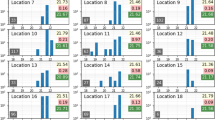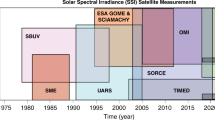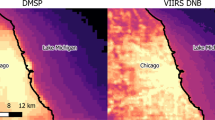Abstract
The increasing sensitivity of modern sky surveys allow ever fainter emissions of light to be detected, but it also increases the chances of noticeable overlap between multiple sources of light, a phenomenon called blending. The consequences of blending are expected to be among the leading systematic measurement uncertainties of future surveys, such as the Legacy Survey of Space and Time. This Perspective discusses two main approaches to addressing blending: attempting to separate individual sources and statistically correcting for the presence of blending at the population level. For both approaches, simultaneous access to data of multiple surveys will be critical to construct a joint data set that combines the strengths of each individual survey.
This is a preview of subscription content, access via your institution
Access options
Access Nature and 54 other Nature Portfolio journals
Get Nature+, our best-value online-access subscription
$29.99 / 30 days
cancel any time
Subscribe to this journal
Receive 12 digital issues and online access to articles
$99.00 per year
only $8.25 per issue
Buy this article
- Purchase on Springer Link
- Instant access to full article PDF
Prices may be subject to local taxes which are calculated during checkout

Similar content being viewed by others
References
Dark Energy Survey Collaboration et al. The Dark Energy Survey: more than dark energy – an overview. Mon. Not. R. Astron. Soc. 460, 1270–1299 (2016).
Aihara, H. et al. The Hyper Suprime-Cam SSP survey: overview and survey design. Publ. Astron. Soc. Jpn. 70, S4 (2018).
Ivezić, Ž. et al. LSST: from science drivers to reference design and anticipated data products. Preprint at arXiv http://arxiv.org/abs/0805.2366 (2008).
Sanchez, J., Mendoza, I., Kirkby, D. P. & Burchat, P. R. Effects of overlapping sources on cosmic shear estimation: Statistical sensitivity and pixel-noise bias. Preprint at arXiv http://arxiv.org/abs/2103.02078 (2021).
Bosch, J. et al. The Hyper Suprime-Cam software pipeline. Publ. Astron. Soc. Jpn. 70, S5 (2018).
Samuroff, S. et al. Dark energy survey year 1 results: the impact of galaxy neighbours on weak lensing cosmology with IM3SHAPE. Mon. Not. R. Astron. Soc. 475, 4524–4543 (2018).
Huang, S. et al. Characterization and photometric performance of the Hyper Suprime-Cam software pipeline. Publ. Astron. Soc. Jpn. 70, S6 (2018).
Chang, C. et al. The effective number density of galaxies for weak lensing measurements in the LSST project. Mon. Not. R. Astron. Soc. 434, 2121–2135 (2013).
Hartlap, J., Hilbert, S., Schneider, P. & Hildebrandt, H. A bias in cosmic shear from galaxy selection: results from ray-tracing simulations. Astron. Astrophys. 528, A51 (2011).
Dawson, W. A., Schneider, M. D., Anthony Tyson, J. & James Jee, M. The ellipticity distribution of ambiguously blended objects. Astrophys. J. 816, 11 (2015).
Hoekstra, H., Viola, M. & Herbonnet, R. A study of the sensitivity of shape measurements to the input parameters of weak-lensing image simulations. Mon. Not. R. Astron. Soc. 468, 3295–3311 (2017).
Martinet, N. et al. Euclid preparation - IV. impact of undetected galaxies on weak-lensing shear measurements. Astron. Astrophys. 627, A59 (2019).
Melchior, P. & Goulding, A. D. Filling the gaps: Gaussian mixture models from noisy, truncated or incomplete samples. Astron. Comput. 25, 183–194 (2018).
Calzetti, D. The dust opacity of star-forming galaxies. Publ. Astron. Soc. Pac. 113, 1449 (2001).
Stetson, P. B. DAOPHOT: a computer program for crowded-field stellar photometry. Publ. Astron. Soc. Pac. 99, 191 (1987).
Linde, P. High precision crowded field photometry. Highlights Astron. 8, 651–656 (1989).
Feder, R. M., Portillo, S. K. N., Daylan, T. & Finkbeiner, D. Multiband probabilistic cataloging: a joint fitting approach to point-source detection and deblending. Astron. J. 159, 163 (2020).
Hubble, E. P. Extragalactic nebulae. Astrophys. J. 64, 321–369 (1926).
Sérsic, J. L. Influence of the atmospheric and instrumental dispersion on the brightness distribution in a galaxy. Bol. Asoc. Argent. Astron. Plata Argent. 6, 41–43 (1963).
Spergel, D. N. Analytical galaxy profiles for photometric and lensing analysis. Astrophys. J. Suppl. Ser. 191, 58 (2010).
Hogg, D. W. & Lang, D. Replacing standard galaxy profiles with mixtures of Gaussians. Publ. Astron. Soc. Pac. 125, 719 (2013).
Bertin, E. & Arnouts, S. SExtractor: software for source extraction. Astron. Astrophys. Suppl. Ser. 117, 393–404 (1996).
Jarvis, M. et al. The DES science verification weak lensing shear catalogues. Mon. Not. R. Astron. Soc. 460, 2245–2281 (2016).
Drlica-Wagner, A. et al. Dark energy survey year 1 results: The photometric data set for cosmology. Astrophys. J. Suppl. Ser. 235, 33 (2018).
Stoughton, C., Lupton, R. H., Bernardi, M., Blanton, M. R. & Burles, S. Sloan digital sky survey: early data release. Astron. J. 123, 485–548 (2002).
Paatero, P. & Tapper, U. Positive matrix factorization: a non-negative factor model with optimal utilization of error estimates of data values. Environmetrics 5, 111–126 (1994).
Lee, D. D. & Seung, H. S. Learning the parts of objects by non-negative matrix factorization. Nature 401, 788–791 (1999).
Melchior, P. et al. Scarlet: source separation in multi-band images by constrained matrix factorization. Astron. Comput. 24, 129–142 (2018).
Melchior, P., Joseph, R. & Moolekamp, F. Proximal Adam: robust adaptive update scheme for constrained optimization. Preprint at arXiv https://ui.adsabs.harvard.edu/abs/2019arXiv191010094M (2019).
Hinton, G. E. & Zemel, R. in Advances in Neural Information Processing Systems Vol. 6 (eds Cowan, J. D., Tesauro, G. & Alspector, J.) 3–10 (Morgan-Kaufmann, 1994). https://proceedings.neurips.cc/paper/1993/file/9e3cfc48eccf81a0d57663e129aef3cb-Paper.pdf.
Kingma, D. P. & Welling, M. Auto-encoding variational bayes. Preprint at arxiv http://arxiv.org/abs/1312.6114v10 (2013).
Arcelin, B., Doux, C., Aubourg, E. & Roucelle, C. Deblending galaxies with variational autoencoders: a joint multiband, multi-instrument approach. Mon. Not. R. Astron. Soc. 500, 531–547 (2021).
Ronneberger, O., Fischer, P. & Brox, T. in International Conference on Medical Image Computing and Computer-Assisted Intervention – MICCAI 2015, 234–241 (Springer, 2015). https://doi.org/10.1007/978-3-319-24574-4_28.
Boucaud, A. et al. Photometry of high-redshift blended galaxies using deep learning. Mon. Not. R. Astron. Soc. 491, 2481–2495 (2020).
Lanusse, F. et al. Deep generative models for galaxy image simulations. Mon. Not. R. Astron. Soc. 504, 5543–5555 (2021).
Salimans, T., Karpathy, A., Chen, X. & Kingma, D. P. PixelCNN++: Improving the PixelCNN with discretized logistic mixture likelihood and other modifications. Preprint at arXiv http://arxiv.org/abs/1701.05517 (2017).
Lanusse, F., Melchior, P. & Moolekamp, F. Hybrid physical-deep learning model for astronomical inverse problems. Preprint at arXiv http://arxiv.org/abs/1912.03980 (2019).
Kaiser, N. Addition of images with varying seeing. Technical report http://pan-starrs.ifa.hawaii.edu/project/people/kaiser/imageprocessing/im++.pdf (2004).
Zackay, B. & Ofek, E. O. How to COAAD images. I. Optimal source detection and photometry of point sources using ensembles of images. Astrophys. J. 836, 187 (2017).
Daylan, T., Portillo, S. K. N. & Finkbeiner, D. P. Inference of unresolved point sources at high galactic latitudes using probabilistic catalogs. Astrophys. J. 839, 4 (2017).
Liu, R., McAuliffe, J. D. & Regier, J. Variational inference for deblending crowded starfields. Preprint at arXiv http://arxiv.org/abs/2102.02409 (2021).
He, K., Gkioxari, G., Dollár, P. & Girshick, R. Mask R-CNN. Preprint at arXiv http://arxiv.org/abs/1703.06870 (2017).
Burke, C. J. et al. Deblending and classifying astronomical sources with Mask R-CNN deep learning. Mon. Not. R. Astron. Soc. 490, 3952–3965 (2019).
Vaisanen, P., Tollestrup, E. V. & Fazio, G. G. Confusion limit resulting from galaxies: using the infrared array camera on board SIRTF. Mon. Not. R. Astron. Soc. 325, 1241–1252 (2001).
Kamath, S. Challenges for dark energy science: color gradients and blended objects. PhD thesis, Stanford Univ (2020).
Hausen, R. & Robertson, B. E. Morpheus: a deep learning framework for the pixel-level analysis of astronomical image data. Astrophys. J. Suppl. Ser. 248, 20 (2020).
Jones, D. M. & Heavens, A. F. Bayesian photometric redshifts of blended sources. Mon. Not. R. Astron. Soc. 483, 2487–2505 (2019).
Joseph, R., Courbin, F. & L. Starck, J. Multi-band morpho-spectral component analysis deblending tool (MuSCADeT): deblending colourful objects. Astron. Astrophys. Suppl. Ser. 589, A2 (2016).
Bryant, J. J. et al. The SAMI galaxy survey: instrument specification and target selection. Mon. Not. R. Astron. Soc. 447, 2857–2879 (2015).
Bundy, K. et al. Overview of the SDSS-IV MaNGA survey: mapping nearby galaxies at Apache Point Observatory. Astrophys. J. 798, 7 (2015).
Johnston, E. J. et al. SDSS-IV MaNGA: bulge–disc decomposition of IFU data cubes (BUDDI). Mon. Not. R. Astron. Soc. 465, 2317–2341 (2017).
Hopkins, P. F. et al. FIRE-2 simulations: physics versus numerics in galaxy formation. Mon. Not. R. Astron. Soc. 480, 800–863 (2018).
Kado-Fong, E., Kim, J.-G., Ostriker, E. C. & Kim, C.-G. Diffuse ionized gas in simulations of multiphase, star-forming galactic disks. Astrophys. J. 897, 143 (2020).
Kim, W.-T., Kim, C.-G. & Ostriker, E. C. Local simulations of spiral galaxies with the TIGRESS framework. I. Star formation and arm spurs/feathers. Astrophys. J. 898, 35 (2020).
Korytov, D. et al. CosmoDC2: A synthetic sky catalog for dark energy science with LSST. Astrophys. J. Suppl. Ser. 245, 26 (2019).
The LSST Dark Energy Science Collaboration et al. The LSST DESC DC2 simulated sky survey. Astrophys. J. Suppl. Ser. 253, 31 (2020).
Potter, D., Stadel, J. & Teyssier, R. PKDGRAV3: beyond trillion particle cosmological simulations for the next era of galaxy surveys. Comput. Astrophys. Cosmol. 4, 2 (2017).
Troxel, M. A. et al. A synthetic Roman Space Telescope High-Latitude Imaging Survey: simulation suite and the impact of wavefront errors on weak gravitational lensing. Mon. Not. R. Astron. Soc. 501, 2044–2070 (2021).
Torrey, P. et al. Synthetic galaxy images and spectra from the Illustris simulation. Mon. Not. R. Astron. Soc. 447, 2753–2771 (2015).
Suchyta, E. et al. No galaxy left behind: accurate measurements with the faintest objects in the dark energy survey. Mon. Not. R. Astron. Soc. 457, 786–808 (2016).
Everett, S. et al. Dark energy survey year 3 results: measuring the survey transfer function with Balrog. Preprint at arXiv http://arxiv.org/abs/2012.12825 (2020).
Shipley, H. et al. HFF-DeepSpace Photometric Catalogs of the 12 Hubble Frontier Fields, Clusters, and Parallels: Photometry, Photometric Redshifts, and Stellar Masses. Astrophys. J. Suppl. Ser. 235, 14 (2018).
Eckert, K. et al. Noise from undetected sources in dark energy survey images. Mon. Not. R. Astron. Soc. 497, 2529–2539 (2020).
Gruen, D. et al. Dark energy survey year 1 results: the effect of intracluster light on photometric redshifts for weak gravitational lensing. Mon. Not. R. Astron. Soc. 488, 4389–4399 (2019).
Kannawadi, A. et al. Towards emulating cosmic shear data: revisiting the calibration of the shear measurements for the Kilo-Degree Survey. Astron. Astrophys. 624, A92 (2019).
Sheldon, E. S., Becker, M. R., MacCrann, N. & Jarvis, M. Mitigating shear-dependent object detection biases with metacalibration. Astrophys. J. 902, 138 (2020).
Mandelbaum, R. et al. Weak lensing shear calibration with simulations of the HSC survey. Mon. Not. R. Astron. Soc. 481, 3170–3195 (2018).
Kacprzak, T. et al. Measurement and calibration of noise bias in weak lensing galaxy shape estimation. Mon. Not. R. Astron. Soc. 427, 2711–2722 (2012).
Huff, E. & Mandelbaum, R. Metacalibration: direct self-calibration of biases in shear measurement. Preprint at arXiv http://arxiv.org/abs/1702.02600 (2017).
Sheldon, E. S. & Huff, E. M. Practical weak-lensing shear measurement with metacalibration. Astrophys. J. 841, 24 (2017).
Hoekstra, H., Kannawadi, A. & Kitching, T. D. Accounting for object detection bias in weak gravitational lensing studies. Astron. Astrophys. 646, A124 (2021).
MacCrann, N. et al. DES Y3 results: blending shear and redshift biases in image simulations (2020). Preprint at arXiv http://arxiv.org/abs/2012.08567 (2020).
Connor, T. et al. Crowded field galaxy photometry: precision colors in the CLASH clusters. Astrophys. J. 848, 37 (2017).
Greco, J. P. et al. Illuminating low surface brightness galaxies with the Hyper Suprime-Cam survey. Astrophys. J. 857, 104 (2018).
Zhang, Y. et al. Dark energy survey year 1 results: detection of intracluster light at redshift ~0.25. Astrophys. J. 874, 165 (2019).
Palmese, A. et al. Comparing dark energy survey and HST–CLASH observations of the galaxy cluster RXC J2248.7–4431: implications for stellar mass versus dark matter. Mon. Not. R. Astron. Soc. 463, 1486–1499 (2016).
Koekemoer, A. M. et al. The cosmos survey: Hubble space telescope advanced camera for surveys observations and data processing. Astrophys. J. Suppl. Ser. 172, 196–202 (2007).
Scoville, N. et al. COSMOS: Hubble space telescope observations. Astrophys. J. Suppl. Ser. 172, 38–45 (2007).
Merlin, E. et al. T-PHOT version 2.0: Improved algorithms for background subtraction, local convolution, kernel registration, and new options. Astron. Astrophys. 595, A97 (2016).
Nyland, K. et al. An application of multi-band forced photometry to one square degree of SERVS: accurate photometric redshifts and implications for future science. Astrophys. J. Suppl. Ser. 230, 9 (2017).
Rhodes, J. et al. Scientific synergy between LSST and Euclid. Astrophys. J. Suppl. Ser. 233, 21 (2017).
Rhodes, J. et al. Cosmological synergies enabled by joint analysis of multi-probe data from WFIRST, Euclid, and LSST. Bull. Am. Astron. Soc. 51, 201 (2019).
Chary, R. et al. Joint survey processing of LSST, Euclid and WFIRST: Enabling a broad array of astrophysics and cosmology through pixel level combinations of datasets. Preprint at arXiv http://arxiv.org/abs/1910.01259 (2019).
Joseph, R., Melchior, P. and Moolekamp, F. Joint survey processing: combined resampling and convolution for galaxy modelling and deblending. Preprint at arXiv https://arxiv.org/abs/2107.06984 (2021).
Strauss, M. A. et al. Spectroscopic target selection in the Sloan Digital Sky Survey: the main galaxy sample. Astron. J. 124, 1810 (2002).
Dawson, K. S. et al. The Baryon oscillation spectroscopic survey of SDSS-III. Astron. J. 145, 10 (2013).
Takada, M. et al. Extragalactic science, cosmology, and Galactic archaeology with the Subaru Prime Focus Spectrograph. Publ. Astron. Soc. Jpn. 66, R1 (2014).
Foley, R. J. et al. LSST observing strategy white paper: LSST observations of WFIRST deep fields. Preprint at arXiv http://arxiv.org/abs/1812.00514 (2018).
Koekemoer, A. et al. Ultra deep field science with WFIRST. Bull. Am. Astron. Soc. 51, 550 (2019).
Hartley, W. G. et al. Dark energy survey year 3 results: deep field optical + near-infrared images and catalogue. Preprint at arXiv http://arxiv.org/abs/2012.12824 (2020).
York, D. G. et al. The Sloan Digital Sky Survey: Technical summary. Astron. J. 120, 1579 (2000).
Dey, A. et al. Overview of the DESI legacy imaging surveys. Astron. J. 157, 168 (2019).
Grogin, N. A. et al. CANDELS: the cosmic assembly near-infrared deep extragalactic legacy survey. Astrophys. J. Suppl. Ser. 197, 35 (2011).
Koekemoer, A. M. et al. CANDELS: the cosmic assembly near-infrared deep extragalactic legacy survey — the Hubble Space Telescope observations, imaging data products, and mosaics. Astrophys. J. Suppl. Ser. 197, 36 (2011).
Acknowledgements
J.S. acknowledges that this document was prepared using the resources of the Fermi National Accelerator Laboratory (Fermilab), a U.S. Department of Energy, Office of Science, HEP User Facility. Fermilab is managed by Fermi Research Alliance, LLC (FRA), acting under contract no. DE-AC02-07CH11359.
Author information
Authors and Affiliations
Contributions
The authors contributed equally to all aspects of the article.
Corresponding author
Ethics declarations
Competing interests
The authors declare no competing interests.
Additional information
Peer review information
Nature Reviews Physics thanks Dustin Lang and the other, anonymous, reviewer(s) for their contribution to the peer review of this work.
Publisher’s note
Springer Nature remains neutral with regard to jurisdictional claims in published maps and institutional affiliations.
Related links
Euclid Deep Fields: https://www.cosmos.esa.int/web/euclid/euclid-survey
Hubble Legacy Archive: https://hla.stsci.edu/
Rights and permissions
About this article
Cite this article
Melchior, P., Joseph, R., Sanchez, J. et al. The challenge of blending in large sky surveys. Nat Rev Phys 3, 712–718 (2021). https://doi.org/10.1038/s42254-021-00353-y
Accepted:
Published:
Issue Date:
DOI: https://doi.org/10.1038/s42254-021-00353-y



